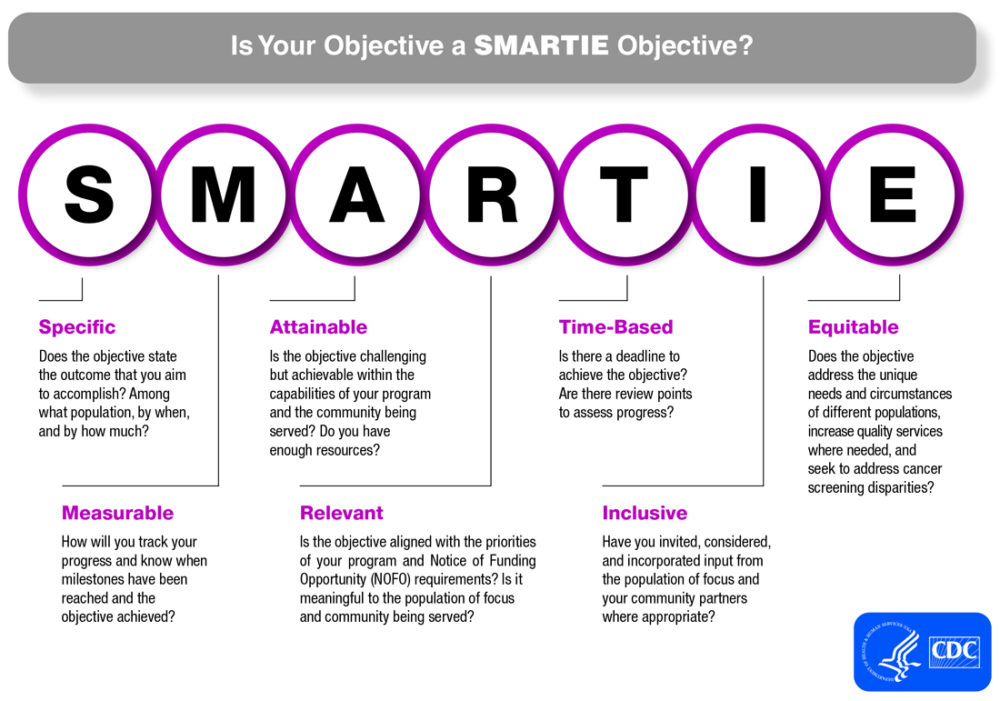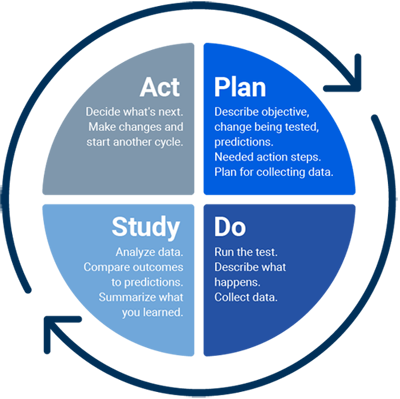
Take Action - A Toolkit for School Systems to Advance Comprehensive School Employee Wellness
- Brandon Stratford
- Bonnie Solomon
- Joy Thompson
- Devan O’Toole
- Kaylor Garcia
- Kajol Surani
- Michael Martinez
- Sarah Her
Step 2: Take Action
Before a school system can begin to advance employee wellness, it should either establish a planning team to guide the process or leverage an existing team. A planning team should reflect the diversity of positions, tenure, and sociodemographic characteristics among school system employees and be able to identify and implement strategies to equitably improve school employee wellness. This section of the toolkit outlines steps for planning teams, accompanied by links to practical tools.
- Establish a diverse and inclusive team
- Assess readiness to make and sustain change
- Collect data to assess needs and assets
- Use data to set priorities
- Develop a plan
- Implement, improve, and sustain efforts
- Communicate early and often to keep people invested
1. Establish a diverse and inclusive team
Diverse teams often perform better than teams that reflect a limited set of personal characteristics and backgrounds, and an inclusive team culture ensures that differences become a source of strength and creativity (review the Equity and Inclusion on Planning Teams section). Teams should first identify a lead point of contact to coordinate the overall initiative—someone who can help create an inclusive team culture. Once a team is formed, it should establish a meeting schedule that includes time for focusing on team functioning, identifying data-driven priorities, and carrying out an equity-focused action plan. Team leads should be mindful of the time required to establish an inclusive, high-functioning team and adjust team members’ job responsibilities to accommodate the time commitment required to participate. Meeting times should accommodate all team members, including those who work part-time or outside typical working hours (i.e., food service, transportation, and maintenance staff).

Tools you can use
The resources below include practical guidance on establishing and maintaining effective planning teams. Some resources include interactive trainings while others include personal reflection and team activities, worksheets, and tipsheets.
| Team leadership
Team recruitment |
Team functioning
Team diversity and inclusion |
2. Assess readiness to make and sustain change

Efforts to implement organizational change are often unsuccessful when planning teams do not assess their organization’s level of readiness for change. Readiness assessment efforts should engage individuals who reflect school system employees with respect to positions, tenure, and sociodemographic characteristics (including individuals who are not on the formal planning team) to most effectively identify potential challenges and creative solutions. See the Centering Equity in Planning Processes section of this toolkit for more information and practical tools.
This readiness assessment can guide an examination of a school system’s current readiness to advance equitable school employee wellness, which may include discontinuing strategies that are not working. It allows for reflection on readiness in three areas that will shape actions carried out at the school and school system levels: (1) school district context, (2) senior leaders’ support for employee wellness, and (3) capacity to advance employee wellness.
The value of this assessment is not in achieving a specific score. Rather, planning teams can reflect on their own responses (and those of other key stakeholders) to identify what strengths already exist within their school system and where growth is needed.

Tools you can use
3. Collect data to assess needs and assets
Implementing policies, programs, and practices based on employee wellness data builds buy-in and engagement and increases the chances that staff will benefit. While it is common for school systems to look at data related to employee health conditions and work experiences, district policies that influence employee well-being and working conditions should also be reviewed by the planning team as a part of assessing needs and assets. Community-level data on well-being can also be helpful to understand how a community’s social determinants of health might affect school employees. Generally, teams will not need to start from scratch to collect data, as most school systems already collect data relevant to comprehensive school employee wellness. A non-comprehensive list of data sources appears below.
Most teams will find gaps in data for assessing school employee wellness, which may include incomplete, limited, or unclear data from certain groups of staff. These gaps can be caused by systemic issues related to data collection, such as having limited data on some wellness topics or having low participation in a survey among particular groups of employees based on concerns about how the data will be used. Available data may also be limited to certain wellness domains, or of questionable quality. While planning teams may decide they need new data to fill these gaps, teams should remember that more data is not always better or feasible. Before collecting more data, teams should identify and address any systemic barriers that could negatively impact participation in data collection—especially among employees who have historically been underrepresented—to ensure that new data address high-priority gaps and are of high quality. The University of Kansas’ online Community Tool Box has extensive resources, including tips on collecting data to assess school system needs and assets.
Existing surveys
Even if planning teams decide they need new employee wellness data, they may not need to start from scratch. Existing surveys include:
4. Use data to set priorities
Most school systems collect and analyze student achievement data; however, while many also collect data on school employee wellness, those data may not be analyzed frequently or robustly. The following strategies can be used to examine school employee wellness data. Regardless of which strategies teams use to review data, they should engage perspectives that reflect the range of job positions and sociodemographic characteristics of school system employees—and disaggregate data when possible—to jointly interpret data and determine differences in wellness across all employees. See Collect data to assess needs and assets for more on the collection of data.
5. Develop a plan
Teams’ plans to improve school employee wellness should be informed by data they have collected and analyzed, with an eye toward achieving equity. Many resources are available to help teams develop a plan, including the guidance below on developing SMARTIE objectives. There is no single best way to develop an action plan, but following a research-based process can help teams avoid overlooking important steps. The Tools You Can Use section below includes links to several research-based tools.

Most plans will need to balance individual and structural changes. For example, school employee wellness programs help employees establish healthy habits related to nutrition, physical activity, adequate sleep, and stress management. However, any plan must also reflect school systems’ influence on employee wellness (see the Framework section for more), especially around reducing job stressors. See the Tools you can use in this section for potential strategies.

Tools you can use
The resources below include practical guidance on developing a data-driven plan.
6. Implement, improve, and sustain efforts
Equitable and sustainable school employee wellness is a journey, not a destination, and requires teams to track whether their changes result in the intended outcomes. Even if interventions work as intended, teams should periodically reassess employee needs and assets to ensure that plan priorities reflect changes in their needs. To sustain support for employee wellness efforts, teams should regularly update stakeholders about progress and highlight successful efforts.
Continuous Quality Improvement (CQI) is a process by which team members review data to assess progress toward implementing a plan, discuss strengths and opportunities for improvement, and determine whether the selected strategies need to be revised or new strategies introduced (to be re-examined over time). The Tools you can use section includes practical guidance on engaging in Plan-Do-Study-Act (PDSA) cycles, a common framework for CQI.
7. Communicate Early and Often to Keep People Invested
Planning teams—which should include school system leaders—should communicate throughout planning and implementing efforts to improve school employee wellness. However, what a team communicates and to whom will likely change over time.
Build buy-in
At the beginning of efforts to improve school employee wellness, communication should focus on building buy-in from stakeholders to cultivate support and allow the team to hear about employees’ concerns and aspirations. Messages will need to be tailored to help all stakeholder groups understand how improving school employee wellness is aligned with their unique interests.

Tools you can use
The resources below include brief documents, videos, and guidance that can help build buy-in among a variety of key audiences.
- Teacher stress and health: Effects on teachers, students, and schools
- Comprehensive school employee wellness initiatives can lower financial costs to schools
- Addressing racial equity can boost well-being among school staff and students of color
- Wellness Ideas to Make Your Whole School Healthier (video)
- Health Equity Video Series
- School Wellness Champion Start-Up Kit
Maintain connections
Throughout planning and implementation, teams should engage with stakeholders on progress and obtain feedback on early efforts. Most school systems can leverage existing channels (e.g., staff meetings, websites, newsletters, and social media accounts) to provide periodic updates to key audiences. It is especially important that early messaging highlight the use of feedback from employees and other stakeholders. When individuals don’t see their feedback being addressed, it can create distrust.
Celebrate success
Teams should celebrate successes, including small early ones. Highlighting efforts in specific schools , district offices, or community partners can motivate individuals and groups and maintain momentum while more complicated, structural strategies are implemented. These celebrations of quick wins are critical because the most impactful strategies are likely to require time. Examples of celebrations:
- Encourage leaders across the school system to celebrate successes within their teams on a regular basis (e.g., during staff meetings).
- Host an event to recognize efforts across the school system.
- Use social media to highlight school employee wellness activities and events.
- Set and celebrate goals. For example, if an employee retention goal is set and met, school system leaders can host a meeting to tout the success that gives credit to the team.
© Copyright 2024 ChildTrendsPrivacy Statement
Newsletter SignupLinkedInYouTube